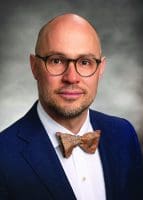A unique perspective informs work aimed at healing healthcare workforces.


If you had asked me in 2005 where I would be in 18 years, I never would have said executive nurse leader. Then, I was a professional clown. Now, I serve as co-chief well-being officer for Emory Healthcare. My current work aspires to advocate for meaningful, progressive, and structural changes to support team well-being. This role isn’t only about well-being for the largest global workforce—nurses—but for anyone who works in healthcare. At the root of my current work sits precious lessons learned while serving as an emergency nurse. At the center of my nursing skills sit life-changing lessons I learned while a clown.
Since 2001, I’ve volunteered with Clowns Without Borders (CWB), whose mission is to share levity, joy, and playfulness in zones of crisis around the world. We’re not the creepy clowns who wear too much face paint or big, fluffy wigs. Our performance comes from rich traditions of dance, theatre, pantomime, and storytelling, dating back to 15th century Italy.
In 2005, my life took a drastic turn. CWB was partnering at a children’s hospital in Okay (Aux Cayes), Haiti. We worked with a group of Haitian nurses and Cuban physicians to perform for children in the ward. As we performed, we met many enthusiastic children eager to dance and play with us. We also saw some of the sickest children I’ve ever seen. One child in particular looked as if she was sleeping. In fact, she was actively dying.
The child’s mother asked us to play some soft music. Afterward, the mother hugged and thanked us. Within an hour, the child had died. I didn’t know this until we were leaving the ward and a physician followed us out. He thanked us for the joy we brought to hospital. He told us that he had been skeptical about having clowns in the wards, but after he saw how we connected with the children and families and transformed the energy of the ward, he understood what healing looked like. He said we were welcome to return anytime. He then told us about the death of the child.
She died of malnutrition. When I heard this, I felt a physical shock move through my entire being. I needed to understand how a child, living just a few hours from the shores of the richest country in the world, a country that spends trillions of dollars on healthcare, could die because of limited access to healthcare, food, and clean water. In that moment I decided to change my career path and study nursing.
Fast forward through countless experiences, which included mentoring by some of the wisest nurses (such as Florence Richardson, ADN, RN, and Jon Bartels, BSN, RN), providing aid during the West Africa Ebola outbreak, and working in multiple level-one trauma centers, the Kutupalong Refugee camp, and in post-2010-earthquake Haiti. I want to bring my bedside nursing experiences to the boardroom tables around which I now sit. In my current work, I strive to apply what I learned to help heal our healthcare workforces.
In her new book, Taking Care: The Story of Nursing and Its Power to Change the World, author Sarah DiGregorio reminds us that since the beginning of time, nurses have always shown up. My nurse mentors taught me how to show up. My training as a clown taught me how to be present and to think differently. The patients and colleagues I’ve worked with continue to show me how we all have the power to heal when we collaborate and challenge the status quo.
Tim Cunningham is co-chief well-being officer at Woodruff Health Sciences Center and adjunct associate professor at the Nell Hodgson Woodruff School of Nursing at Emory University in Atlanta, Georgia.
American Nurse Journal. 2023; 18(11). Doi: 10.51256/ANJ112348


















